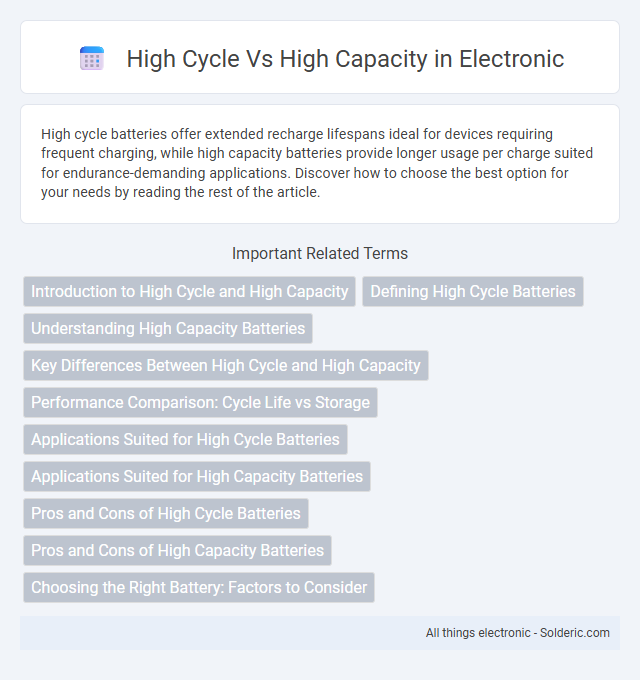High cycle batteries offer extended recharge lifespans ideal for devices requiring frequent charging, while high capacity batteries provide longer usage per charge suited for endurance-demanding applications. Discover how to choose the best option for your needs by reading the rest of the article.
Comparison Table
| Feature | High Cycle | High Capacity |
|---|---|---|
| Definition | Designed for numerous charge and discharge cycles | Designed to store maximum energy per charge |
| Battery Lifespan | Long cycle life (up to thousands of cycles) | Shorter cycle life compared to high cycle batteries |
| Energy Density | Lower energy density | Higher energy density for longer run times |
| Use Case | Ideal for frequent use and applications needing durability (e.g., power tools) | Best for devices requiring extended operation without recharge (e.g., smartphones) |
| Cost | Typically higher due to durability | Generally more affordable per capacity unit |
| Performance | Consistent over time with less degradation | May degrade faster with repeated use |
Introduction to High Cycle and High Capacity
High cycle batteries deliver extended charge-discharge cycles, making them ideal for applications requiring long-term reliability and consistent performance, such as renewable energy storage and electric vehicles. High capacity batteries prioritize maximum energy storage per unit, suitable for devices or systems needing prolonged operation without frequent recharging. Understanding the balance between high cycle life and high capacity is essential for selecting batteries optimized for specific energy demands and usage patterns.
Defining High Cycle Batteries
High cycle batteries are designed to deliver a large number of charge-discharge cycles, often exceeding 2,000 cycles, making them ideal for applications requiring long-term endurance and consistent performance. These batteries maintain capacity and efficiency over extended use, emphasizing longevity rather than maximum energy storage. Your choice of a high cycle battery ensures sustained power output for devices like renewable energy systems and electric vehicles that demand repeated energy cycling.
Understanding High Capacity Batteries
High capacity batteries store more energy, allowing longer usage times between charges compared to standard options, making them ideal for devices with heavy power demands. High cycle batteries emphasize longevity by maintaining capacity after many charge-discharge cycles, ensuring consistent performance over time. Understanding these differences helps you choose the best battery type to match your device's usage needs, balancing runtime and lifespan effectively.
Key Differences Between High Cycle and High Capacity
High cycle batteries are designed to withstand a greater number of charge and discharge cycles, making them ideal for applications requiring long-term durability and repeated use, such as solar energy storage or electric vehicles. High capacity batteries prioritize storing a larger amount of energy per charge, offering extended runtime and better performance in devices like laptops and smartphones, where longer usage between charges is essential. The key difference lies in cycle life versus energy density, with high cycle batteries favoring longevity and high capacity batteries focusing on maximum energy storage.
Performance Comparison: Cycle Life vs Storage
High cycle batteries excel in longevity, delivering thousands of charge-discharge cycles with consistent performance, ideal for applications requiring durability over time. High capacity batteries, however, prioritize energy storage, offering larger watt-hour ratings per charge but typically fewer overall cycles before performance degradation. Evaluating cycle life versus storage capacity highlights a trade-off where high cycle batteries provide extended operational lifespan, while high capacity batteries maximize runtime per cycle.
Applications Suited for High Cycle Batteries
High cycle batteries excel in applications requiring frequent charge and discharge cycles, such as electric vehicles, renewable energy storage, and backup power systems. Their design prioritizes longevity and consistent performance over many cycles, making them ideal for grid stabilization and portable electronics used daily. These batteries maintain capacity and efficiency through thousands of cycles, supporting sustainability and cost-effective energy management in high-demand environments.
Applications Suited for High Capacity Batteries
High capacity batteries are ideal for applications requiring extended energy storage and long runtime, such as electric vehicles, renewable energy systems, and backup power supplies. These batteries excel in scenarios where sustained, consistent power output is critical over extended periods. High capacity lithium-ion and nickel-metal hydride batteries are commonly used in portable electronics and grid storage solutions to maximize operational duration.
Pros and Cons of High Cycle Batteries
High cycle batteries offer exceptional longevity with thousands of charge-discharge cycles, making them ideal for applications requiring frequent use, such as electric vehicles and renewable energy storage. Their main downside is typically lower energy capacity compared to high capacity batteries, resulting in shorter run times between charges. High cycle batteries often have higher upfront costs but provide better total cost of ownership due to extended lifespan and reduced replacement frequency.
Pros and Cons of High Capacity Batteries
High capacity batteries offer extended usage time, reducing the frequency of recharging and enhancing convenience for devices with high energy demands. Their larger size and weight can be a downside, potentially making devices bulkier and less portable. You benefit from longer operational cycles, but may face increased initial cost and slower charging times compared to high cycle batteries optimized for longevity.
Choosing the Right Battery: Factors to Consider
When selecting between high cycle and high capacity batteries, consider the application's energy demands and usage frequency to ensure optimal performance and longevity. High cycle batteries excel in applications requiring frequent recharge cycles, maintaining capacity over thousands of charges, while high capacity batteries provide longer runtimes ideal for short-term heavy energy use. Battery chemistry, cost, environmental impact, and device compatibility are crucial factors influencing the choice to match operational needs accurately.
High cycle vs High capacity Infographic

 solderic.com
solderic.com